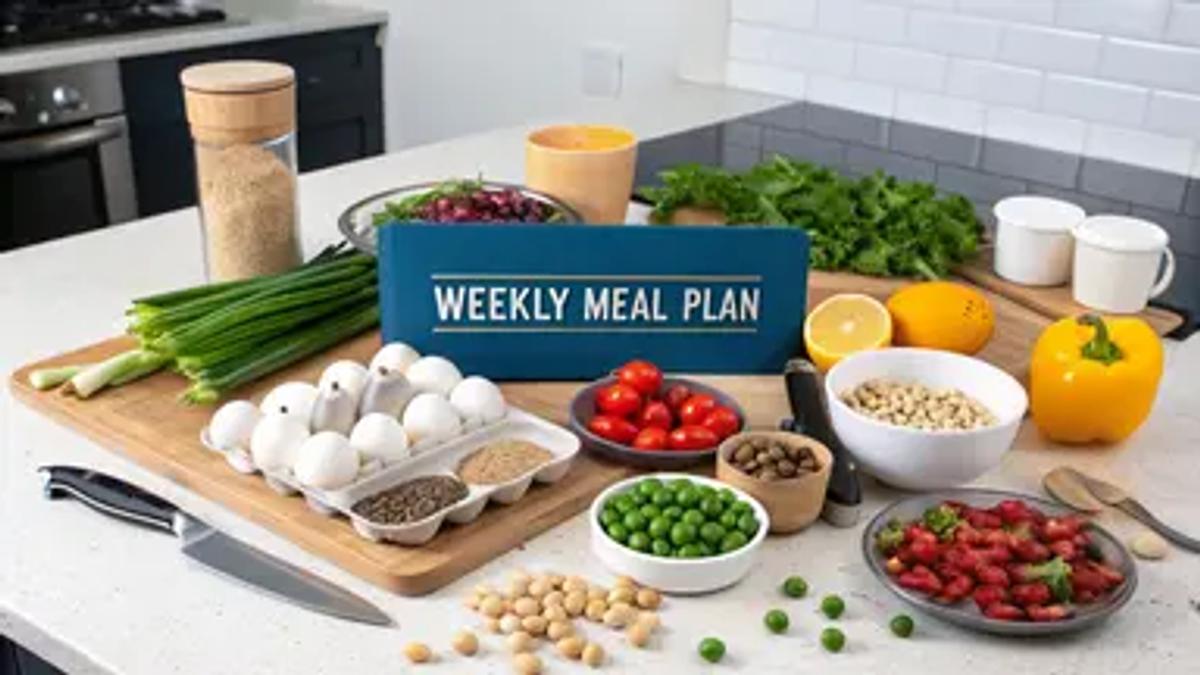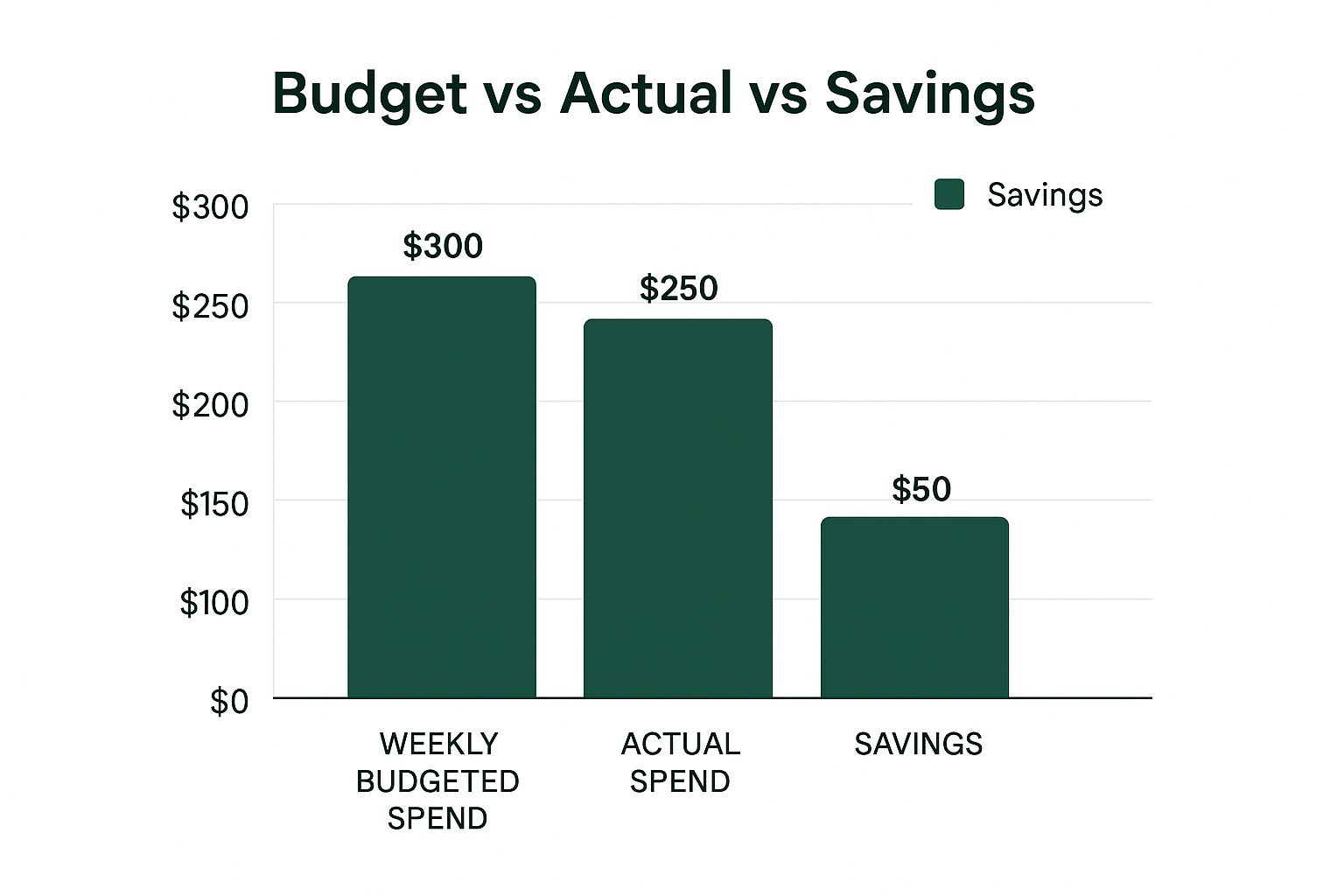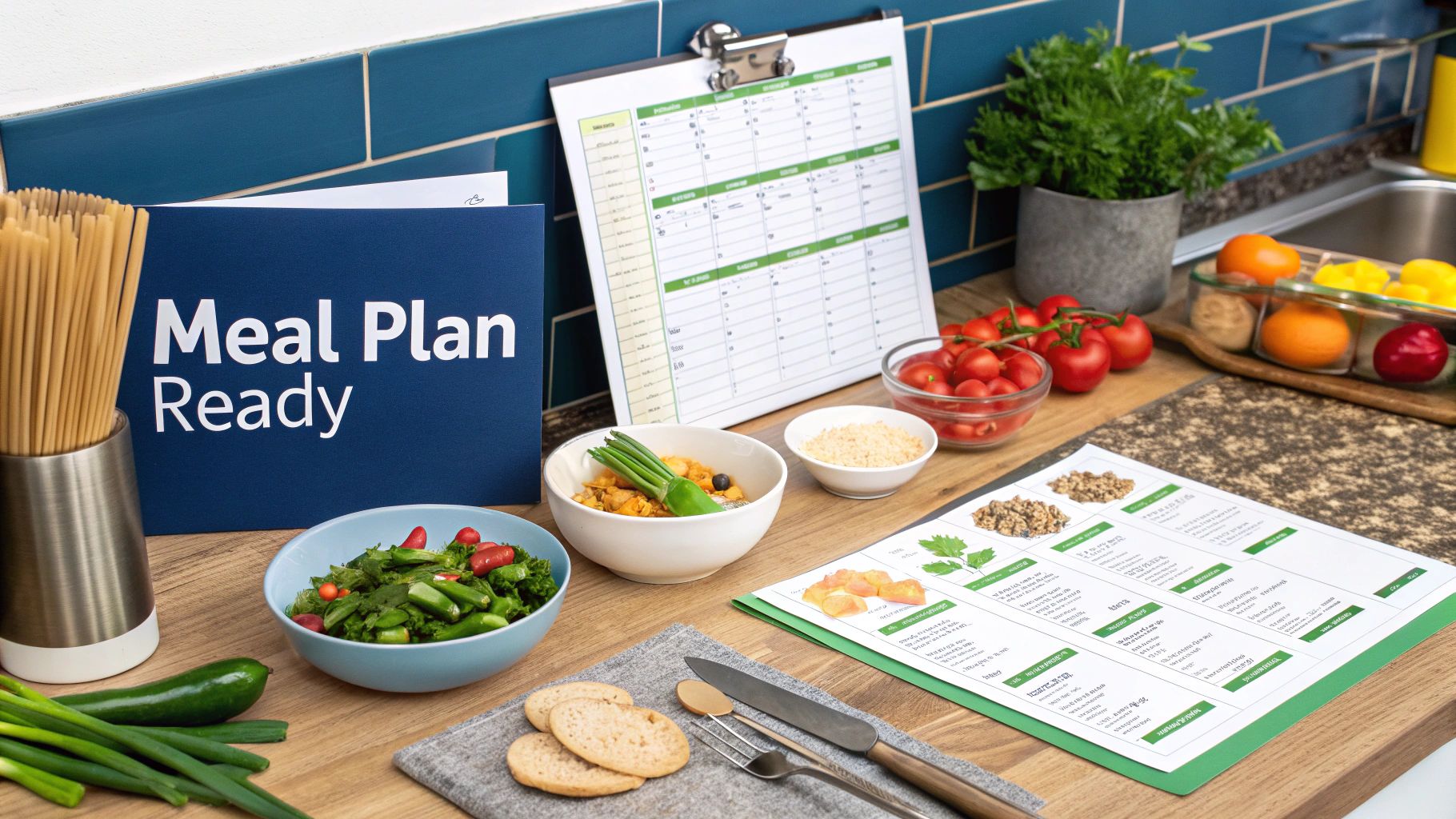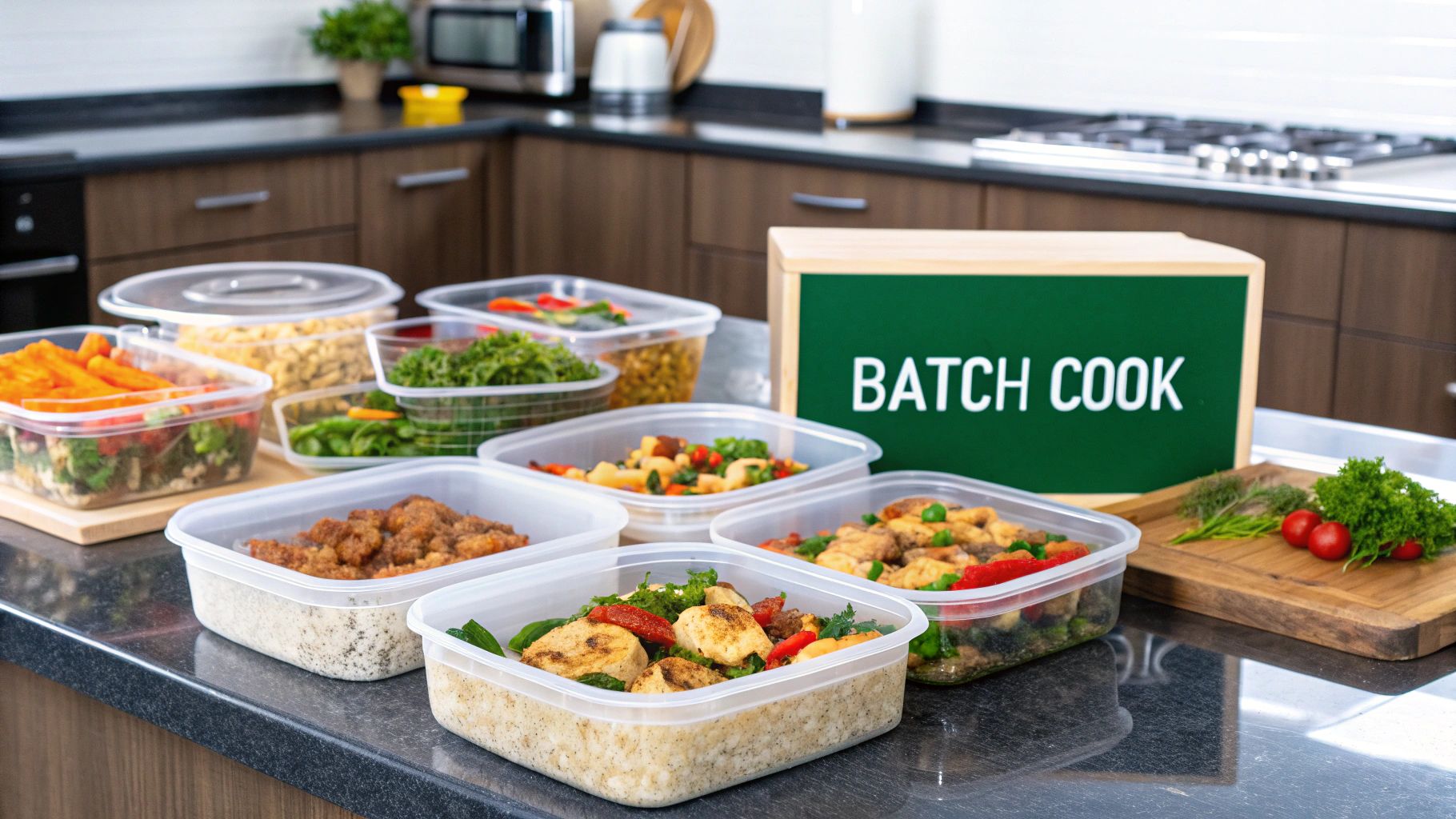A Weekly Meal Plan on a Budget That Actually Works
Discover a realistic weekly meal plan on a budget that saves you time and money. Get practical tips and real-world examples to eat well for less.
Ready to Simplify Your Meal Planning?
Get personalized meal plans and grocery lists automatically matched to your macro targets.

A Weekly Meal Plan on a Budget That Actually Works
Before you even think about writing a grocery list, the secret to a successful budget meal plan begins. It's all about doing a quick "shop" of your own kitchen first. By seeing what you already have, you can build your week around a few core "anchor meals" using versatile, cheap staples you know your family enjoys. This simple bit of prep work is the magic wand that stops overspending in its tracks.
Your Foundation for a Budget-Friendly Meal Plan
Let's bust a myth right now: budget meal planning isn't about eating boring food or getting lost in complicated spreadsheets. The most powerful move you can make happens right in your kitchen, and it’s all about using what you’ve already got. This isn't just about saving a few bucks; it's a total mindset shift. You'll go from being a victim of grocery store sales to the master of your own pantry.
This quick audit transforms those forgotten cans of beans, the lonely bag of frozen peas, and that half-empty box of pasta from clutter into the building blocks of your next delicious meal. It’s how you stop buying a third jar of paprika when you already have two hiding in the back of the cabinet.
Master the Pantry and Freezer Audit
Okay, before you start dreaming up a menu, take ten minutes. Seriously, just ten. Do a quick scan of your pantry, fridge, and freezer. What needs to get eaten? That half-bag of potatoes or those few stray chicken thighs in the freezer aren't problems—they're opportunities. This is step one to creating a weekly meal plan on a budget that actually works.
Next, you need a realistic spending target. A clear budget gives you a goal to shoot for. To give you an idea, the USDA regularly puts out food cost estimates. They aren't perfect, but they're a great starting point for seeing what's reasonable.
I've put together a simple table based on their numbers to help you see where your family might fit in.
Sample Weekly Food Budget Tiers for a Family of Five
| Budget Tier | Estimated Weekly Cost | Best For |
| Thrifty Plan | $273.41 | Households laser-focused on minimizing food costs with simple, staple-based meals. |
| Low-Cost Plan | $361.19 | Families looking for a balance between savings and a bit more variety in their diet. |
| Moderate-Cost Plan | $449.61 | Those who want more flexibility for specialty items, organic choices, or more complex recipes. |
These numbers assume you're making pretty much everything at home. As you can see, there's a wide range of what "budget" can mean, but all of them can support a healthy diet. To get a better feel for it, you can watch a video explaining more about these budget tiers and how they apply to real families.
Build Your Anchor Meals
Now for the fun part. Pick three to five "anchor meals" your family genuinely loves that are built on cheap, flexible staples. These are your trusty, go-to dinners you can practically make with your eyes closed.
- Taco Night: You can use ground meat, lentils, or beans. Throw in whatever veggies you have on hand and serve with tortillas or over rice. So easy.
- Pasta Night: A classic for a reason. Whip up a simple marinara with sausage or get creative with a creamy sauce using frozen peas and bacon bits.
- Hearty Soup: This is the ultimate "use it up" meal. Toss in leftover protein, sad-looking veggies from the crisper drawer, and some broth. You've got a filling, one-pot wonder.
The point isn't to create a rigid, boring schedule that makes you want to rebel by Friday. It's about building a flexible framework. This simplifies your daily "what's for dinner?" panic and makes sure your grocery list is always smart and intentional.
This approach has a real, measurable impact on your wallet. Just look at how planning pays off.

As you can see, the proof is in the pudding (or, in this case, the savings!). When you stick to a plan, the savings add up week after week, turning your budget from a wishful number into a powerful tool for your finances.
Let’s Build Your Menu (Minus the Headache)
Alright, you've taken stock of your pantry and picked out a few "anchor meals." Now for the fun part: sketching out your week. Don't worry, this isn't about creating some rigid, joyless food schedule. Think of it as your secret weapon—a flexible game plan that makes a weekly meal plan on a budget feel less like a chore and more like a victory.
The whole point is to finally kill that dreaded 5 PM "what's for dinner?!" panic while making every single dollar pull its weight.
The heart of this strategy? The "cook once, eat twice" mantra. Seriously, this little concept is a total game-changer for both your time and your bank account. A big pot of chili one night can magically become chili dogs or a topping for baked potatoes the next day. That roast chicken you make on Sunday? It’s the hero of Monday’s chicken salad sandwiches and Tuesday’s creamy chicken noodle soup. See? You're already a meal-planning wizard.
Weave Your Week Around Powerhouse Ingredients
Your anchor meals are a great starting point, but the real magic—and the real savings—happens when you build your week around a few powerhouse ingredients. These are the versatile, low-cost champions of the grocery aisle that can show up in multiple dishes. Stop thinking one ingredient, one meal. Start seeing how a bag of potatoes or a can of beans can play three or four different roles throughout the week.
I’m talking about budget-friendly heroes like:
- Lentils and Beans: They can star in soups, tacos, and salads. Or, my favorite trick, use them as a "stretcher" in ground beef to make a pound of meat go twice as far.
- Potatoes: Mashed, roasted, fried, or baked... is there anything they can't do? They're the ultimate blank canvas for countless cheap, filling meals.
- Seasonal Produce: This is a big one. Building your plan around whatever veggies are on super sale that week is just smart shopping. If broccoli is cheap, we're having broccoli!
- Eggs: Please, don't relegate eggs to just breakfast. A frittata packed with leftover veggies and a little cheese is one of my go-to "I have no idea what to make" dinners. It's fast, cheap, and loaded with protein.
When you focus on ingredients like these, you naturally create a web of meal possibilities that keeps your grocery bill down. You're no longer buying a fancy, one-off ingredient for a single recipe; you're investing in building blocks for your entire week.
Your Flexible 7-Day Meal Framework
Let go of the idea of a strict, meal-by-meal itinerary. Nobody sticks to that. What you really need is a flexible framework. This gives you just enough structure to feel in control but enough wiggle room to adapt when life happens—whether that’s surprise leftovers, a low-energy evening, or a killer sale at the store. This is about having thought-starters, not a food prison.
Look, a meal plan is a guide, not a contract. The only plan that works is the one you actually stick to because it fits your real life—crazy weeknights and all. Give yourself some grace. Flexibility is what will make this a long-term habit.
To get your gears turning, here’s a sample framework. Just plug your own family’s favorites into this structure.
A Peek at a Sample 7-Day Framework
- Monday (Meatless): Veggie and Lentil Soup with some crusty bread for dipping.
- Tuesday (Taco Night): Shredded Chicken Tacos (using that leftover chicken!).
- Wednesday (Pasta Night): Can't go wrong with simple spaghetti and a big side salad.
- Thursday (Leftover Buffet): Time to clean out the fridge! Get creative and use up any leftovers from the week.
- Friday (Fun Food): Homemade Pizza or a build-your-own Burger Night.
- Saturday (Slow Cooker): Pot Roast with Potatoes and Carrots. Set it and forget it.
- Sunday (Cook Once): Roast a Whole Chicken for dinner. Remember to make extra for the week ahead!
A simple structure like this makes your plan delicious, affordable, and—most importantly—doable. This is how you create a budget meal plan that you don't actually hate.
Crafting a Grocery List That Actually Protects Your Wallet

Alright, you've got your meal plan. That's your roadmap. But your grocery list? That’s the armored truck that gets your money safely from the bank to its destination.
Let’s be real. Strolling into a grocery store without a list—or with a vague "milk, bread, stuff for dinner" scrawl—is financial suicide. You're basically inviting those BOGO cookies and that artisanal cheese you don't need to hop into your cart. Impulse buys are the number one saboteur of any food budget.
A solid list, however, turns you from a wide-eyed wanderer into a surgical shopping ninja. The mission is simple: get in, grab only what's on your list for your weekly meal plan on a budget, and get out before your willpower drains.
Organize Your List Like the Store Itself
Stop scribbling things down as they pop into your head. That random, chaotic list is why you’re constantly backtracking down the snack aisle for the third time, making eye contact with temptations you'd otherwise miss.
The secret is to organize your list by the store's layout. It's a game-changer. You'll create a super-efficient path from the entrance to the checkout, saving you a surprising amount of time and money.
Group everything by category:
- Produce: All your fresh fruits and veggies go here.
- Protein & Dairy: Lump together your meat, fish, eggs, milk, and yogurt.
- Pantry Staples: This is your zone for pasta, rice, canned tomatoes, spices, flour, etc.
- Frozen: Anything from frozen peas to that chicken breast that was on a killer sale.
This isn’t just about being organized; it’s a mind trick. When you have a clear route, you’re way less likely to wander off course and explore the chip aisle "just for a minute."
Become a Price-Decoding, Aisle-Conquering Pro
To truly own your grocery game, you need to learn the store's secret language. And I'm not talking about the flashy sale signs. I'm talking about the tiny, boring numbers on the shelf tag: the unit price.
This little number tells you the cost per ounce, per pound, or per item. It’s the only real way to know if that jumbo "family size" box is a better deal than two smaller ones. Spoiler: it often isn't.
Think of your grocery list as a signed contract with yourself. It's a physical shield against the brilliant marketing designed to separate you from your cash.
This skill is more important than ever. Food prices are always on the move. The latest forecasts for 2025, for example, predict that food-at-home prices will jump by another 2.2%. A detailed list is your best defense against feeling that pinch. You can nerd out on the data and see the full food price forecast from the USDA's Economic Research Service if you want to see what's coming.
Never forget: supermarkets are designed to make you spend. They hide the milk and eggs in the very back corner for a reason. They want you to walk past thousands of other products to get there. But with your category-based list in hand, you can blow right past those traps, confident that your cart only holds what you came for.
Let Your Phone Do the Heavy Lifting
Look, you can absolutely do this whole meal planning thing with a pen and a crumpled piece of paper. People have for generations. But why would you? You've got a ridiculously powerful computer sitting in your pocket, and it's time to put it to work.
Trying to juggle recipes, grocery sales, and what’s-about-to-go-bad-in-the-fridge can feel like a second job. This is where a good app can be a total game-changer. Think of it as your own personal sous chef—one who happens to be a whiz at budgeting and organization.
These days, meal planning apps are so much more than digital recipe boxes. The smart ones can scan local grocery flyers and suggest meals based on what’s on sale. Imagine an app that not only builds your shopping list for you but also knows you have three bell peppers that need to be used tonight. That’s a direct hit against food waste and a huge win for your wallet.
And this isn't some fringe tech-nerd thing anymore. It's gone mainstream. A recent survey showed that a whopping 67% of adults between 25 and 45 are using digital planners or grocery apps several times a week. It makes perfect sense—we're all trying to save time, slash our grocery bills, and stop throwing away sad, forgotten vegetables. If you're curious, you can discover more about how these apps are changing meal prep.
Finding the Right App for Your Budget
Okay, so the app store is a jungle. How do you pick the right one? Forget the fancy bells and whistles for a second. If your goal is to save money, you need a tool built for exactly that.
Here's what I always tell people to look for:
- "What's In My Fridge?" Recipes: The best feature, hands down. You type in "chicken thighs, rice, broccoli," and it spits out dinner ideas. It's the ultimate way to use up what you already own.
- Sales-Driven Suggestions: Some apps are clever enough to sync with local store flyers. They'll actively push recipes that feature ingredients on deep discount this week.
- Automatic Shopping Lists: This is non-negotiable. Once you pick your meals for the week, the app should instantly generate a shopping list. No more forgetting the garlic.
- Pantry Tracker: A digital list of what you have on hand. It stops you from buying your fifth jar of paprika when you already have four. You just check things off as you use them.
The whole point here is to find tech that makes your life easier, not more complicated. The right app should feel like a cheat code, freeing you up to actually enjoy cooking instead of getting lost in the logistics.
Here's a peek at what a solid meal planning app interface looks like. It’s clean, combines recipes with nutrition info, and makes planning feel less like a chore.

See how it lays everything out? It makes planning a balanced week almost effortless. Some platforms, like Meal Flow AI, even take it a step further. They'll not only plan your meals but will also shoot the final grocery list straight over to Instacart for delivery. The entire process—from "what's for dinner?" to groceries at your door—boils down to a few taps on your screen. Now that's how you save some serious time and money.
Pro Moves to Stretch Your Food Budget Further

Okay, you've got your menu planned and a shopping list that's practically a military mission plan. You're feeling good. But let me tell you, the real magic happens after the grocery run.
This is where you transform from a planner into a true budget kitchen ninja. It’s all about a few smart habits that make a weekly meal plan on a budget work even harder for you. These aren't complicated chef techniques; they're simple, clever moves that make every single dollar you spent go the distance.
Master the Art of Component Cooking
One of the biggest game-changers for my kitchen chaos and my bank account was when I finally leaned into "component cooking." It sounds fancy, but it’s dead simple. Instead of prepping five complete, separate meals on a Sunday, you just prep the versatile parts of meals.
This little switch makes whipping up a healthy dinner on a crazy Tuesday night feel like you're cheating. You aren’t starting from scratch; you’re just playing with Legos, snapping delicious pieces together.
Here are a few of my go-to component preps:
- Cook a Big Batch of Grains: Having cooked quinoa, brown rice, or even just some pasta ready and waiting in the fridge is a total lifesaver. It’s the instant foundation for a grain bowl, a quick side dish, or the perfect filler to bulk up a soup.
- Shred Some Chicken: That delicious roasted chicken from Sunday dinner? Don't let the leftovers get lost in the back of the fridge. Shred all that meat and you've got instant fillings for tacos, the star of a chicken salad, or something to toss into a quick pasta.
- Roast a Sheet Pan of Veggies: Chop up a bunch of broccoli, bell peppers, onions, and sweet potatoes, toss them with some olive oil and spices, and roast until they're perfect. These can be thrown into omelets, piled onto salads, or served next to literally any protein all week long.
Make Your Freezer Your Best Friend
Your freezer is so much more than a frosty graveyard for ice cream and forgotten leftovers. It's a time machine! It hits pause on freshness, locking in flavor and, more importantly, savings. When you spot a can't-miss sale, your freezer is what gives you the power to stock up without the fear of anything going bad.
Think of your freezer as your own private, fully-stocked grocery store where everything is already paid for. It's your secret weapon against the siren song of takeout when you're tired and feel like there's "nothing to eat."
Here’s how to use it like a pro:
- Bread and Buns: See that "buy one, get one free" deal on your favorite loaf? Grab it. Toss one straight into the freezer. It thaws out perfectly, I promise.
- Meat and Poultry: When ground beef or chicken breasts hit a price that makes you do a double-take, buy extra. The key is to portion it out into meal-sized servings before freezing. This saves you from having to defrost a giant, frozen brick of meat later.
- Leftover Soups and Sauces: That extra chili or spaghetti sauce is future-you's best friend. Pour it into freezer-safe bags, squeeze the air out, and lay them flat to freeze. They take up way less space and thaw in minutes for a ridiculously fast dinner down the road.
Aim for Zero Food Waste
Getting to "zero waste" sounds intense, but honestly, every little step you take in that direction is more money back in your wallet. It's all about shifting your perspective and seeing the hidden potential in things you’d normally just toss in the bin.
Those limp celery stalks, onion ends, and carrot peels? Don't you dare throw them out! Keep a big bag in your freezer and just add to it. When it’s full, dump it all in a pot, cover with water, and simmer for a few hours. Boom. You've just made a rich, delicious vegetable broth for free.
Got some stale bread? Cube it up, toss it with a little olive oil and whatever herbs you have, and bake it into fantastic, crunchy croutons. That apple with a few bruises? Chop it, simmer it with a splash of water and cinnamon, and you've got instant applesauce. Every scrap you rescue is another dollar you didn't have to spend.
Got Questions? I’ve Got Answers.
Even the most perfectly crafted meal plan can get derailed by, well, real life. What do you do when your kid suddenly declares war on broccoli? Or when you get home from a brutal day at work and would rather do anything but cook?
Don't panic. These aren't signs you’ve failed; they're just part of the game. Let's walk through some of the most common questions I hear. Having a game plan for these hiccups is what keeps you from ditching your plan and dialing for pizza.
"Help! My Kid Only Eats Beige Food."
Ah, the picky eater. It can feel like you're a short-order cook running a failing restaurant. The secret weapon here isn't to force them to eat a complicated casserole, but to break it down. Think "deconstructed" meals.
Instead of a fully mixed-up taco salad, lay out all the ingredients buffet-style: a bowl of seasoned ground turkey, shredded lettuce, diced tomatoes, cheese, and a few different tortilla options. This gives everyone—especially little ones—a sense of control. They get to build their own plate, which makes them infinitely more likely to actually eat what's on it.
Another pro move? Get them in on the planning. Let each kid pick one dinner theme for the week. When "Taco Tuesday" was their idea, the buy-in is huge. And for those nights when it's a total standoff, have a couple of dirt-cheap, always-a-winner backups ready, like cheesy quesadillas or scrambled eggs and toast. Problem solved.
"Should I Shop Weekly or Do a Huge Monthly Haul?"
This is the classic debate, and honestly, the answer is... both! A hybrid approach is where you'll find the magic. If you try to do one massive shop for the entire month, you’re almost guaranteed to watch your fresh produce wilt into a sad, gooey mess. On the flip side, going to the store every week opens the door to tons of impulse buys.
Here’s the strategy that has saved me countless dollars and headaches:
- The Monthly Stock-Up: Once a month, I do a big run for all my non-perishable heroes. This is for things like rice, pasta, canned beans, oils, spices, and frozen goods. I grab these when they're on a deep sale.
- The Weekly Refresh: Then, once a week, I do a quick trip for the fresh stuff—produce, milk, yogurt, bread, and any meat or fish on that week’s menu.
This system gives you the best of both worlds. You lock in bulk savings on pantry items and ensure your fresh ingredients are actually fresh, which drastically cuts down on food waste.
"What If I’m Too Exhausted to Cook Every Night?"
Let’s get real for a second. Nobody has the energy to cook a full meal from scratch seven nights a week. Life is just too chaotic for that. Your meal plan shouldn't be a prison sentence; it should be your get-out-of-jail-free card.
Your weekly meal plan isn’t about forcing you to cook daily; it’s about making sure you have a plan for not cooking, too. Planned leftover nights are your best friend!
This is where the glorious "cook once, eat twice" philosophy comes into play. When you make that giant pot of chili on Monday, you’re not just making dinner. You’re making Wednesday’s dinner, too. I literally write "Leftover Night" into my weekly plan. No shame in that game!
You can also embrace "component prepping." Just spend an hour on Sunday dicing onions, cooking a big batch of rice or quinoa, and grilling some chicken. When you do the grunt work ahead of time, throwing dinner together on a Tuesday night can take less than 20 minutes.
---
Ready to stop juggling lists and start enjoying effortless meal planning? Meal Flow AI builds your perfect weekly menu and sends the grocery list straight to Instacart.